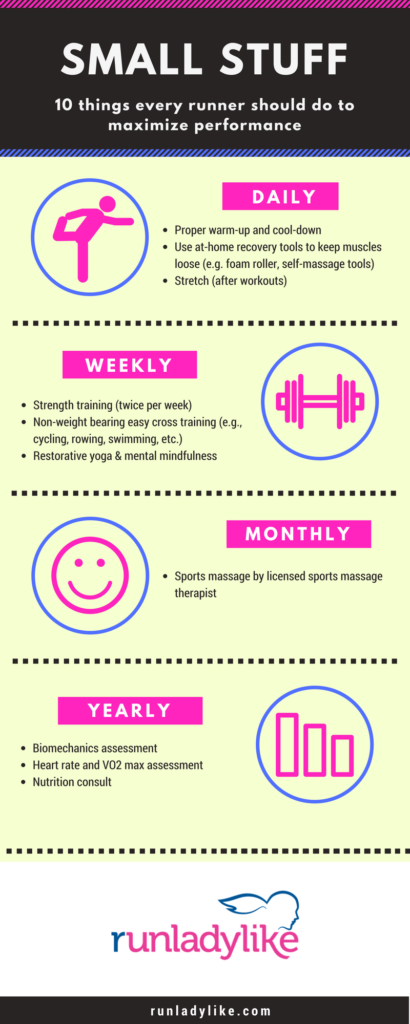Why the Small Stuff Matters: 10 “Little” Things Every Runner Should Do
It’s certainly true that to become a better runner, we have to run more. But running alone will not make us the strongest runners we can be. Through coaching marathoners and training with many different runners, I commonly see runners skip the small stuff. The “small stuff” is what I refer to as the ancillary activities that supplement our running to prevent muscle imbalances, reduce injury and maximize performance. As I’ve been thinking about my own running comeback and starting to rebuild my base again next month after having a baby, the small stuff is going to be more critical than ever for me personally in charting a healthy return to my favorite sport.
I know what you’re thinking: I’m already so busy. I work or watch my kids full time, I have a million commitments, I’m trying to run my household and I’m already running and training every day. There is no more room to fit anything else in. But isn’t an extra 5 to 30 minutes out of your day worth it to remain injury-free and to be your strongest running self? If you can’t get to the start line of a big goal race healthy, I promise you your answer will be yes.
Here is a list of the supplemental running activities I recommend for runners – daily, weekly, monthly and annually.

DAILY: Do these things every day
1. Proper warm-up and cool-down: Every workout every day should begin with a warm-up such as slow easy running and dynamic stretching and end with slow easy running and static stretching. Running drills can also be incorporated into a dynamic warm-up. Read this article to find a warm-up and cool-down routine you can do.
2. At-home recovery tools: Keep your muscles loose and relieve tightness with a daily self-massage protocol. You can use a foam roller on places like your hips, glutes, IT bands, quads, hamstrings, calves, etc. Get deeper in tough areas with a lacrosse ball or massage tools like those from Tiger Tail, which is my favorite. I love their Curve Ball. It’s easy to use these tools while watching TV in the evening.
3. Stretching: In addition to your self-massage protocol, stay limber by stretching your muscles, including upper and lower body.
WEEKLY: Do these things weekly
4. Strength training: Spend 20-30 minutes twice per week strengthening key areas where runners tend to be weak, including hips, glutes, hamstrings, abdominals and upper body. Focused strength training can help prevent muscle imbalances that lead to injury. This hip and glute routine can help you strengthen key muscles. I also like the Iron Strong workout from Dr. Jordan Metzel, the upper and lower body workouts in Meb for Mortals, select workouts from Beachbody (e.g. Hammer and Chisel, 21-Day Fix, etc.) and Jillian Michaels DVDs. Barre classes are also a great option.
5. Cross-training: Incorporate cross training into your week of workouts at least one to two times per week to increase endurance without adding additional pounding on your joints and legs. Focus on exercises that don’t bear weight, such as cycling/spinning, rowing and swimming. The elliptical machine is another good alternative if/when you are experiencing any aches and pains.
6. Restorative yoga: I am a huge fan of restorative yoga (restorative, yin or gentle yoga) to complement our training. Holding gentle stretches for longer periods of time can help with injury prevention while also aiding in mental strength building and personal mindfulness. We are always racing from one thing to the next. Being forced to quiet the mind and the body isn’t always easy. Often I will think about an intention like finding strength or focusing in on a big goal while meditating at the beginning and end of class. Many runners don’t like restorative yoga because it doesn’t “feel” like a workout. Even though you won’t sweat, it will help you be a stronger runner.
MONTHLY: Do this monthly
7. Sports massage: One of the most important things I think any runner can do is get regular sports massage from a licensed sports massage therapist. Deep tissue massage performed by someone who understands runners and the anatomy of runners goes so far in preventing injury or nipping aches and pains in the bud. I am a huge believer that sports massage can fix most injuries before they start if gotten frequently enough. Opt for 90 minutes when possible and go as often as your budget will allow. It is something that feels like a big investment at times but pays off huge dividends when you are running strong and getting to the start line healthy. Read more about the benefits of sports massage for runners here.
YEARLY: Consider doing these activities annually
8. Biomechanics assessment: A biomechanics expert can look at your running gait to assess your form, stride and where there may be opportunities for improvement to prevent or heal injuries. They will prescribe workouts and stretches specific to your needs to help improve areas of weakness.
9. Heart rate and VO2 max assessment: Understanding your heart rate training zones and VO2 max is an important tool to ensure you are running slow enough on your easy/recovery days and fast enough on your speed and tempo days. Read more about heart rate training here. Getting tested annually can help you assess improvements or changes in your fitness and intensity level.
10. Nutrition consult: Nutrition is one of the biggest challenges many runners face. Talking to a registered dietitian about the foods and fuel that work best for you can be really helpful, especially for establishing a daily nutrition plan (not just one for race weekend). In the meantime, this is my road map for long run and race day nutrition.
Do you take time to focus on the “small stuff” as part of your training? What additional supplemental activities do you do daily, weekly, monthly or yearly?



Comments
I love how you broke down everything by daily, weekly, monthly and yearly! I am always in need of reminders and motivation to do the little things! Question-do the benefits of squats and other exercises for strength decrease if you sprinkle them throughout a day, as oppose to one 30 minute session? Just a thought!
Hi Kara! I’m glad you found this info helpful. Strength training is so important. Most coaches and experts recommend doing strength training to complement your running at least twice a week. The good news is that we don’t need to spend hours doing it. A 20-minute session is adequate. It can immediately follow a run or be done in the evening if your run is done in the morning. I’d recommend doing your strength work all in one session, although it could be a second short workout of the day. I would prioritize hip, glute, hamstring and leg work first, and then core and arms second. Most runners tend to have really weak hips and glutes, which lead to muscle imbalances that cause IT band issues, plantar fasciatis, calf tightness, etc. etc. Core and upper body work can help with running posture and breathing, especially in later stages of a long run or marathon. Single leg work is key (like pistol squats, lunges, single leg dead lifts, etc.). Using one of those workout bands is also really helpful (the kind that is a small circle and can go around your ankles and thighs). I am also a big fan of barre classes, which tend to give your whole body a good strength workout while focusing a lot on the muscles that impact runners.
This is a great way to break down the year into the things that you need! Love the infographic too! Great advice Jes! Now if only I could find time to squeeze in those massages!